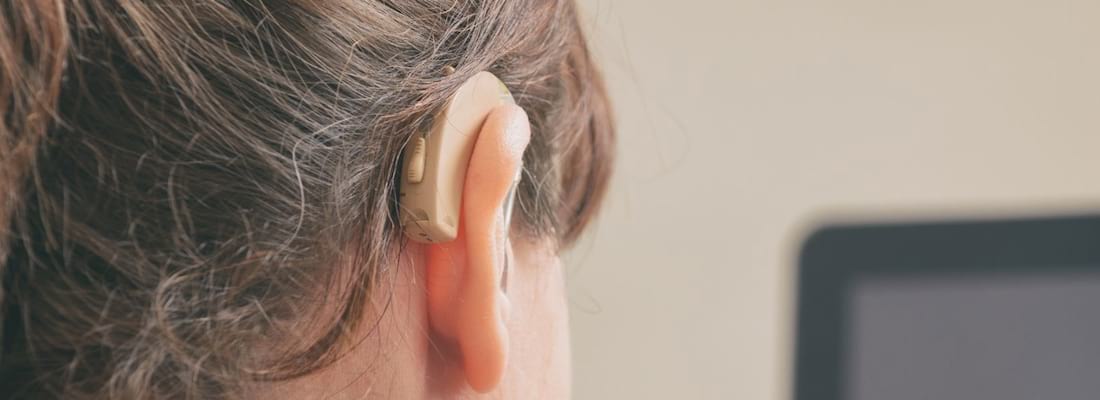The average person sees hearing loss as black or white – you either have normal hearing or you have a hearing loss. However, it’s not always as simple as that. We regularly treat individuals that have just one ear that is not functioning, something referred to as Single Sided Deafness (SSD). In this blog, we are going to take a look at SSD in more detail.
WHAT EXACTLY IS SINGLE SIDED DEAFNESS?
Single sided deafness (SSD) is a type of unilateral hearing loss where the reduction of hearing in one ear is so severe that the ear is considered non-functional. SSD is quite common and can occur in both adults and children. With SSD, the patient often has difficulty determining the direction of sound and separating background noise from the sounds they want to hear. Speech can also start to sound muffled with SSD, with letters such as “s” and “f” sounding less clear. This can lead to distress and social problems both at work and at home for the individual. Feelings of frustration and isolation are common when trying to complete daily tasks, which can lead to reduced contact with family and friends, and result in feelings of isolation and depression. Untreated SSD can also make it difficult to stay connected to communication and entertainment devices like TV and phones.
If sound occurs on the side of the bad ear, then your ear will block the sound from travelling to your good ear. Audiologists call this the “head-shadow effect”, which mainly tends to affect consonants, the higher frequency sounds important for understanding speech.
Unfortunately, there is no cure for SSD, and many sufferers learn to live with the symptoms often asking to be spoken to in their “good ear”. Sufferers often experience Tinnitus, turn the volume of household appliances up louder or feel fatigued from a day of listening. In this case, coping with untreated SSD can become particularly challenging.
POSSIBLE CAUSES OF SINGLE SIDED DEAFNESS
The deficit is usually severe, with the sufferer presenting near or total deafness resulting from infection, disease, or a work-related accident. SSD can also be inherited, or it can be caused by an acoustic neuroma. This is a benign, slow growing tumour that can push against the sudatory nerve and affect the ability to hear in one ear. Additional causes include Meniere’s disease, labyrinthitis, microtia and mastoiditis.
TIPS TO PROTECT YOUR EARS AGAINST SINGLE SIDED DEAFNESS
- - Walk away from loud noises.
- - Wear protective hearing equipment in noisy work environments.
- - Turn the volume of household appliances down.
- - Give your ears time to rest and recover after exposure to loud noises.
- - Do not put anything small in your ear (including cotton swabs).
- - Get regular hearing check-ups and screening.
TREATMENT
Although SSD can’t be cured, there are treatments available to help patients to cope with the effects of SSD. Hearing aids such as the Contralateral Routing of Signal (CROS) and Bilateral Contralateral Routing of Signals (BI-CROSS) are the main options for treatment.
What is a CROS hearing aid?
Traditional hearing aids send sound to the ear that they are sitting in. However, CROS hearing aids consist of two devices sitting in the ears, they pick up sound from the deaf side and send it to the hearing ear. The sound detected by the aid on the "bad ear" is transmitted directly to the aid on the "good ear". This gets rid of the “head shadow” effect. So, all hearing signals from both sides of the head are being processed on the good side.
What is a BI-CROS hearing aid?
A BiCROS hearing aid is similar to a CROS hearing aid but is for people who are deaf in one ear and also hearing impaired in their better ear. The device is worn in the better ear, it both amplifies sound being received by the good ear and receives sound transmitted from the bad ear. Essentially the Bi-Cross system consists of one normal hearing aid in the good ear and a sound transmitter worn in the bad ear.
SINGLE SIDED HEARING LOSS TREATMENT AT AUDIOLOGY MEDICAL SERVICES
At Audiology Medical Services, we often come across patients with SSD. We are committed to providing premium patient care and as we are an independent audiology practice, we have the luxury of offering a range of solutions to suit each customer’s individual needs and budget. We offer specially designed modern CROS systems in our nationwide hearing practices.
For patients with SSD, we use cutting edge Phonak and Widex wireless instruments which transmit sound from the deaf ear to the better ear. The solution is discreet and easily fitted with a non-invasive procedure. Following the fitting of your hearing aid, our team of experts will work with you through our extensive rehabilitation programme to teach you management techniques, resulting in increased confidence and enhanced quality of life.
AUDIOLOGY MEDICAL SERVICES
If you are concerned about yourself or a loved one’s hearing, we are here to help you through this challenging process and help limit the impact it makes on your life. To make an appointment to talk to one of Audiology Medical Services’ clinically trained professional audiologists, available at clinics nationwide, freephone 1800 501 501.









0 Comments
Add Comment